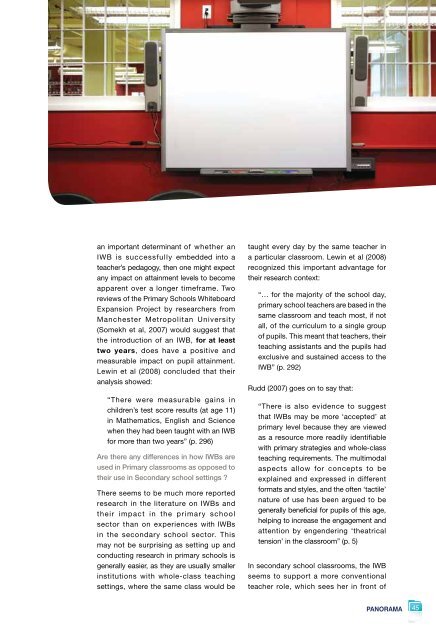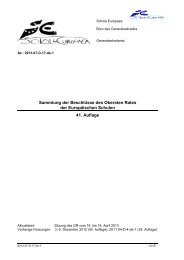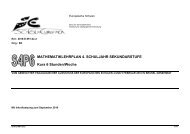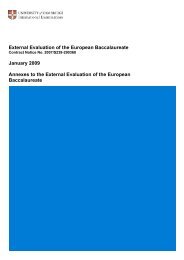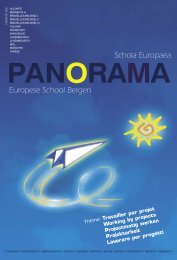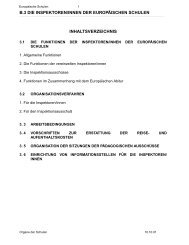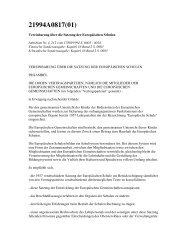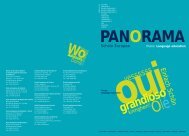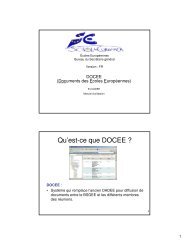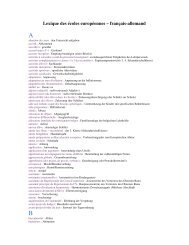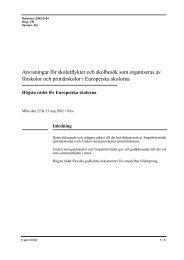Schola Europaea European School Brussels II
Schola Europaea European School Brussels II
Schola Europaea European School Brussels II
Create successful ePaper yourself
Turn your PDF publications into a flip-book with our unique Google optimized e-Paper software.
an important determinant of whether an<br />
IWB is successfully embedded into a<br />
teacher’s pedagogy, then one might expect<br />
any impact on attainment levels to become<br />
apparent over a longer timeframe. Two<br />
reviews of the Primary <strong>School</strong>s Whiteboard<br />
Expansion Project by researchers from<br />
Manchester Metropolitan University<br />
(Somekh et al, 2007) would suggest that<br />
the introduction of an IWB, for at least<br />
two years, does have a positive and<br />
measurable impact on pupil attainment.<br />
Lewin et al (2008) concluded that their<br />
analysis showed:<br />
“There were measurable gains in<br />
children’s test score results (at age 11)<br />
in Mathematics, English and Science<br />
when they had been taught with an IWB<br />
for more than two years” (p. 296)<br />
Are there any differences in how IWBs are<br />
used in Primary classrooms as opposed to<br />
their use in Secondary school settings ?<br />
There seems to be much more reported<br />
research in the literature on IWBs and<br />
their impact in the primary school<br />
sector than on experiences with IWBs<br />
in the secondary school sector. This<br />
may not be surprising as setting up and<br />
conducting research in primary schools is<br />
generally easier, as they are usually smaller<br />
institutions with whole-class teaching<br />
settings, where the same class would be<br />
taught every day by the same teacher in<br />
a particular classroom. Lewin et al (2008)<br />
recognized this important advantage for<br />
their research context:<br />
“… for the majority of the school day,<br />
primary school teachers are based in the<br />
same classroom and teach most, if not<br />
all, of the curriculum to a single group<br />
of pupils. This meant that teachers, their<br />
teaching assistants and the pupils had<br />
exclusive and sustained access to the<br />
IWB” (p. 292)<br />
Rudd (2007) goes on to say that:<br />
“There is also evidence to suggest<br />
that IWBs may be more ‘accepted’ at<br />
primary level because they are viewed<br />
as a resource more readily identifiable<br />
with primary strategies and whole-class<br />
teaching requirements. The multimodal<br />
aspects allow for concepts to be<br />
explained and expressed in different<br />
formats and styles, and the often ‘tactile’<br />
nature of use has been argued to be<br />
generally beneficial for pupils of this age,<br />
helping to increase the engagement and<br />
attention by engendering ‘theatrical<br />
tension’ in the classroom” (p. 5)<br />
In secondary school classrooms, the IWB<br />
seems to support a more conventional<br />
teacher role, which sees her in front of<br />
PANORAMA<br />
45


